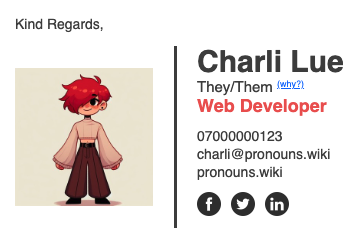Typically, society has taught us to make automatic assumptions about what pronouns to use for someone. If a person's gender expression (the way they appear in terms of gender) seems to be masculine, we'd likely use he/him/his when talking about that person; if a person's appearance seems to be feminine, we'd be likely to use she/her/hers.
However, gender is not always that simple. Sometimes a person's gender doesn't align with their gender expression (the way they look). In addition, not everyone expresses themselves strictly masculine or feminine.
When a person includes their gender pronouns on their email signature line (or on a nametag, when introducing themselves, etc.), they are simply taking the guesswork away for you! It's their way of saying "when you refer to me using pronouns (opposed to by my name), these are the pronouns I'd like for you to use."
Sharing pronouns helps reduce instances of misgendering, which can be distressing and harmful to all individuals, but particularly those who are trans or non-binary.




